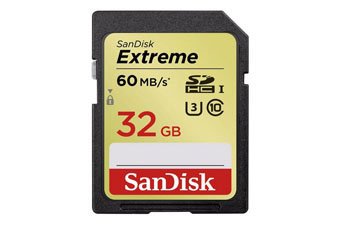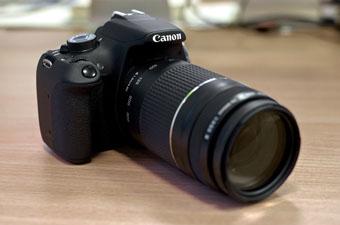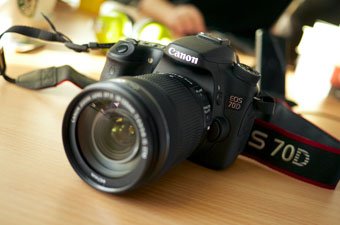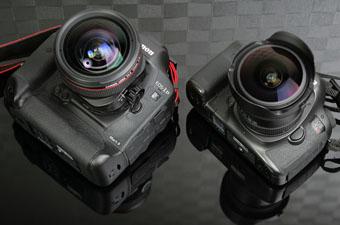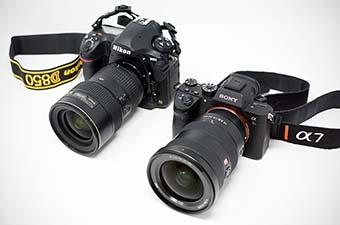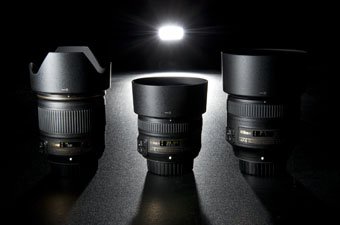The Nikon D5500 is one of the top crop sensor digital SLRs on the market, featuring touchscreen functionality on the rear LCD, improved ergonomics that make the camera easier to grip, and a weight of only 14.2 ounces. Two kits are available for the D5500 (described below), and there are a number of other zoom and prime lenses that can fill out your camera bag nicely. Below are the best lenses for the Nikon D5500 from wide-angle to telephoto. Like most of Nikon’s new DSLRs, the D5500 has a built-in distortion correction mode, which helps to offset the imperfections of many zoom lenses.
Nikon D5500 Kit Lenses
Nikon 18-55mm f/3.5-5.6 VR II ($847 for the kit)
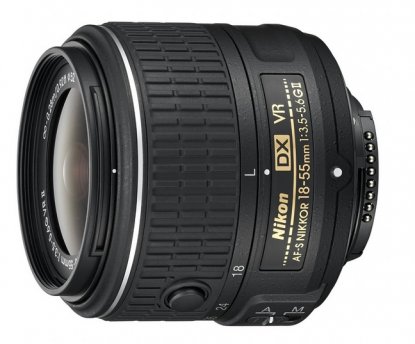 Weight: 6.9 oz.
Weight: 6.9 oz.
35mm equivalent: 27-82.5mm
Maximum aperture: f/3.5
What we like: Lightweight and inexpensive.
What we don't: Optics are merely decent and there is a lot of plastic in the build and mount.
The 18-55mm VR II may not be up to the lofty standards of enthusiasts and professionals, but it’s a perfectly decent introductory lens that will get you out of the door and shooting good photos in no time. Compared to previous versions, the VR II is sharper and about 20% lighter. You can expect some distortion at the wide end, but this can be corrected in-camera on the Nikon D5500. And the lens isn't great in low light with a maximum aperture of f/3.5-5.6, but at only $100 more than the cost of the camera body alone, it’s an enticing option nevertheless. At the very least, you can carry it as a backup should you decide to add other lenses down the road.
See the Nikon 18-55mm VR II Kit
Nikon 18-140mm f/3.5-5.6 VR ($1,047 for the kit)
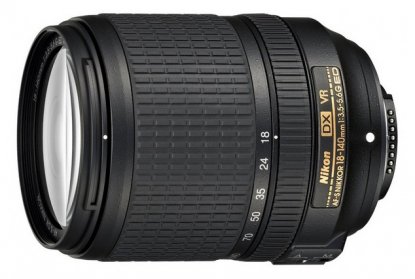 Weight: 17.3 oz.
Weight: 17.3 oz.
35mm equivalent: 27-210mm
Maximum aperture: f/3.5
What we like: A much more complete lens than the 18-55mm above.
What we don't: Doesn't cover the full telephoto end of the spectrum.
Walk-around zoom lenses have become increasingly popular and the Nikon 18-140mm VR is one of our favorites. It’s sharp, has vibration reduction, and a considerably longer zoom ange than the 18-55mm VR II above. For portraits and travel, this is a terrific lens that can stay on your D5500 the majority of the time. What are the downsides of this lens? The first is weight, which at over 17 ounces is only a couple of ounces less than the all-in-one lenses below. The second is the focal length range, which offers much more coverage than the 18-55mm but still leaves the need for a true telephoto lens.
See the Nikon 18-140mm VR Kit
All-In-One Lenses
Nikon 18-300mm f.3.5-6.3 VR ($697)
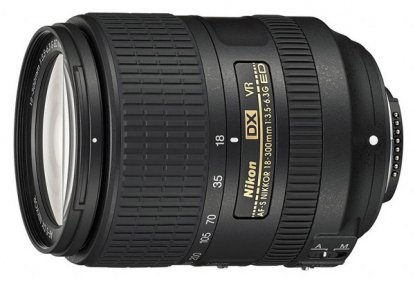 Weight: 19.4 oz.
Weight: 19.4 oz.
35mm equivalent: 27-450mm
Maximum aperture: f/3.5
What we like: Extremely versatile.
What we don't: Some softness and autofocus can hunt on occasion.
An all-in-one lens allows you to cover virtually the entire spectrum of focal lengths without changing lenses. In this category, the Nikon 18-300mm VR is an excellent choice. Released two years ago, the latest version of this lens is lighter and cheaper than post models, with the only sacrifice being a maximum aperture at the long end of f/6.3 instead of f/5.6. The changes are almost all positive, however, and the 18-300mm is the leading all-in-one lens for the Nikon D5500. Amazingly, it weighs less than the Nikon 18-200mm belo and is only $50 cheaper. Unless there is a dramatic change in pricing, we prefer the 18-300mm.
See the Nikon 18-300mm VR
Sigma 18-250mm f/3.5-6.3 Macro OS ($349)
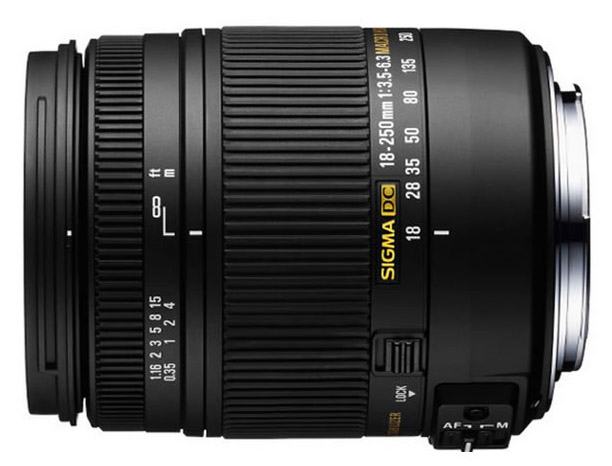 Weight: 16.6 oz.
Weight: 16.6 oz.
35mm equivalent: 27-375mm
Maximum aperture: f/3.5
What we like: All-in-one on a budget.
What we don’t: Can’t compete with the two lenses above in terms of image quality.
For an all-in-one lens on a budget, try the Sigma 18-250mm Macro OS. The biggest selling point is price, which is hundreds of dollars less than either of the Nikon all-in-one lenses on this list. Why is it so much less expensive? First, there is a drop off in aperture at the long end at f/6.3 vs. f/5.6. Second, the optical performance isn’t quite as good with more softness in the corners. Third, the composite material used in the lens barrel isn’t as durable as a harder plastic or metal. But the Sigma 18-250mm is a great value at around $350, and as a bonus, it’s a few ounces lighter than either Nikon option.
See the Sigma 18-250mm
Nikon 18-200mm f/3.5-5.6 VR II ($647)
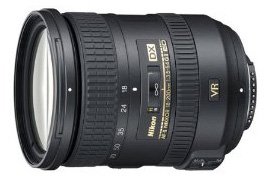 Weight: 19.8 oz.
Weight: 19.8 oz.
35mm equivalent: 27-300mm
Maximum aperture: f/3.5
What we like: Cheaper than the 18-300mm above.
What we don't: Less zoom range for wildlife photography and similar uses.
For years, the Nikon 18-200mm VR II was the leading all-in-one lens for Nikon DX-format cameras. With an equivalent zoom range of 27-300mm on a 35mm camera and vibration reduction technology, this lens captures sharp images throughout its range and has a sturdy build that is made to last. One notable downside of the 18-200mm VR II is that it doesn’t have enough reach for certain types of telephoto photography. Wildlife photographers, for example, likely will need the extra 100mm of length that the 18-300mm above or 55-300mm below have to offer. It’s also heavier than the 18-300mm despite having shorter zoom.
See the Nikon 18-200mm VR II
Wide-Angle Lenses
Nikon 10-24mm f/3.5-4.5 ($797)
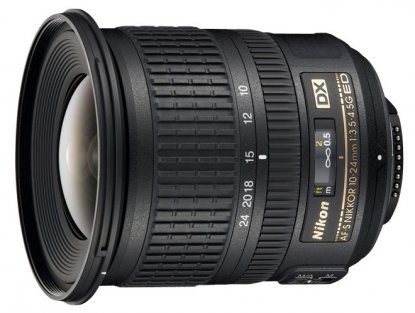 Weight: 16.2 oz.
Weight: 16.2 oz.
35mm equivalent: 15-36mm
Maximum aperture: f/3.5
What we like: Nikon’s best DX wide-angle lens.
What we don't: No vibration reduction.
The 10-24mm f/3.5-4.5 is Nikon’s best wide-angle lens for DX—it’s wider and sharper than any other comparable lens and excellent for landscape photography and architecture. As is the case with virtually all wide-angle zoom lenses, you can expect some distortion at the wide end and the low light performance isn’t as good as a prime. But we love the zoom range, which is equivalent to 15-36mm on a 35mm camera and covers virtually all of the useful focal lengths from ultra-wide to a normal field of view. For a cheaper wide-angle option, see the Tokina 11-16mm below.
See the Nikon 10-24mm
Tokina 11-16mm f/2.8 DX II ($429)
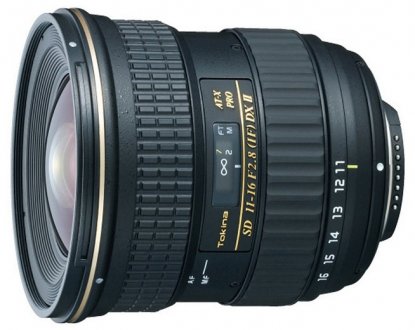 Weight: 19.8 oz.
Weight: 19.8 oz.
35mm equivalent: 16.5-24mm
Maximum aperture: f/2.8
What we like: A reasonably priced wide-angle zoom.
What we don’t: Distortion and weight.
Not everyone has $800 to spend a wide-angle lens, which is where the Tokina 11-16mm steps in. The optics are not quite on par with the Nikon 10-24mm above nor is the focal length range as impressive, but the Tokina is a nice budget option for those who like to dabble in wide-angle photography. It does offer better low light performance by two-thirds of a stop, and the lens is surprisingly sharp and works well for uses like weddings and other events. The most notable downside of this lens is distortion, which is heaviest at the wide end but noticeable all the way through 16mm (the Nikon D5500 does have automatic distortion correction or you can use Photoshop or other editing software on your computer).
See the Tokina 11-16mm DX
Walk Around and Portrait Lenses
Sigma 17-70mm f/2.8-4 ($499)
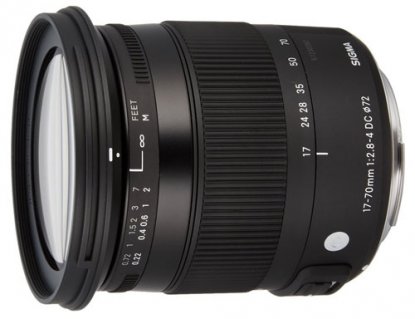 Weight: 16.4 oz.
Weight: 16.4 oz.
35mm equivalent: 25.5-105mm
Maximum aperture: f/2.8
What we like: Less than half the price of the Nikon 16-80mm f/2.8-4.
What we don’t: Softness in the corners.
With all of the buzz surrounding Nikon’s new 16-80mm f/2.8-4, we are going in the other direction and recommending the cheaper Sigma 17-70mm f/2.8-4. The Sigma is less than half the price, has the same maximum aperture, and only slightly less reach at 70mm instead of 80mm. The 25.5-105mm equivalent focal length range is super useful and we love the improved low light performance compared to most other Nikon zooms. This lens is a bit softer than the Nikon 16-80mm, particularly at the corners and when wide open. But it’s a fun lens to learn with and a great value from Sigma.
See the Sigma 17-70mm
Nikon 16-85mm f/3.5-5.6 VR ($697)
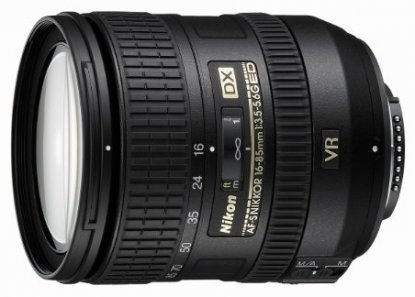 Weight: 17.1 oz.
Weight: 17.1 oz.
35mm equivalent: 24-127.5mm
Maximum aperture: f/3.5
What we like: 16mm at the wide end instead of the usual 18mm.
What we don't: More expensive than the 18-140mm above and less zoom.
If you don’t buy the 18-140mm kit lens above, the Nikon 16-85mm VR is another impressive zoom option. This versatile lens covers a focal length range equivalent of 24-127.5mm on a 35mm camera, hitting everything from wide-angle to medium telephoto portraits. It’s sharp, has fast and accurate autofocus, less distortion than most other comparable zoom lenses, and vibration reduction for hand held photos when natural light is low. All things considered, it’s a quality walk-around lens for portraits and travel.
See the Nikon 16-85mm VR
Nikon 35mm f/1.8 ($177)
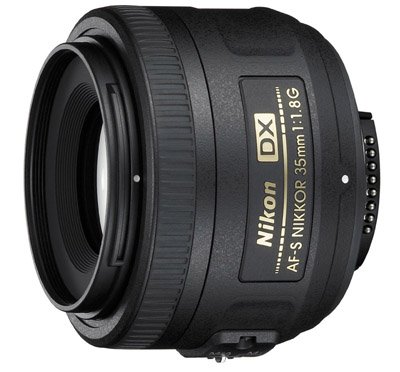 Weight: 7.1 oz.
Weight: 7.1 oz.
35mm equivalent: 52.5mm
Maximum aperture: f/1.8
What we like: Inexpensive and great in low light.
What we don't: Plastic build.
If you plan on shooting travel or street photography with the Nikon D5500, there are few reasons not to add the Nikon 35mm f/1.8 to your bag. This is one of the best lenses in Nikon’s DX lineup—it’s sharp, performs well in low light, and is inexpensive at under $200. You won’t find a better prime walk-around lens for travel or everyday life. One weakness of the Nikon 35mm f/1.8 is that aside from its metal mount, the lens has a plastic build that won’t last forever. But this isn’t a huge risk considering the price, and we still love the 35mm f/1.8.
See the Nikon 35mm
Nikon 50mm f/1.8 ($197)
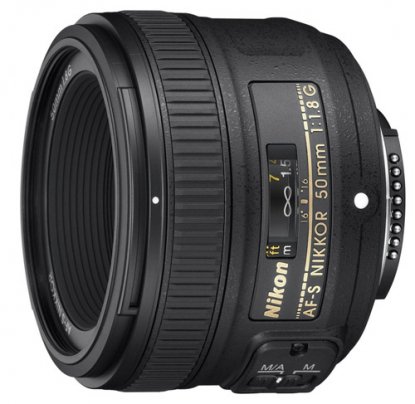 Weight: 6.6 oz.
Weight: 6.6 oz.
35mm equivalent: 75mm
Maximum aperture: f/1.8
What we like: Fast autofocus.
What we don't: A bit pricey because it’s an FX lens.
Similar to the Nikon 35mm above, the popular Nikon 50mm f/1.8 is a great prime lens at a relatively low price. The lens is sharp, performs well in low light, has fast and accurate autofocus, and weighs only 6.6 ounces. The 50mm f/1.8 is an FX lens but is fully compatible with DX-format cameras with an effective focal length of 75mm. The only issue here is that you’re paying a bit of a premium for a full-frame lens, but you may end up appreciating that functionality down the road.
See the Nikon 50mm
Macro Lenses
Nikon 40mm f/2.8 DX Micro ($247)
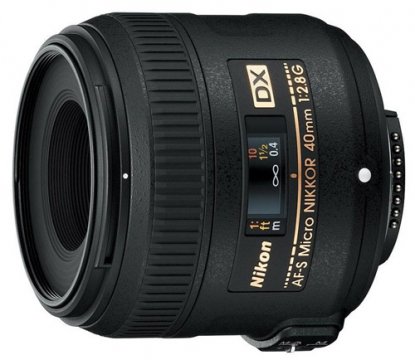 Weight: 9.9 oz.
Weight: 9.9 oz.
35mm equivalent: 60mm
Maximum aperture: f/2.8
What we like: Sharp and inexpensive.
What we don't: 40mm focal length requires getting close to your subject.
There are two main macro lens options for DX (Nikon uses the word “micro”): the 40mm f/2.8 and the 85mm f/3.5. The 40mm f/2.8 is best for non-moving subjects that are easily approached and the lens has a faster maximum aperture by two-thirds of a stop. We really like this lens—it’s sharp, inexpensive, and can focus as close as 6.4 inches from your subject. For uses like flowers, food, or product photography, this is a great macro lens for the Nikon D5500 and a good value. If you shoot macro photography outdoors and need more distance—think living things like insects or animals—try the pricier Nikon 85mm f/3.5.
See the Nikon 40mm Micro
Telephoto Lenses
Nikon 55-200mm f/4-5.6 VR ($143)
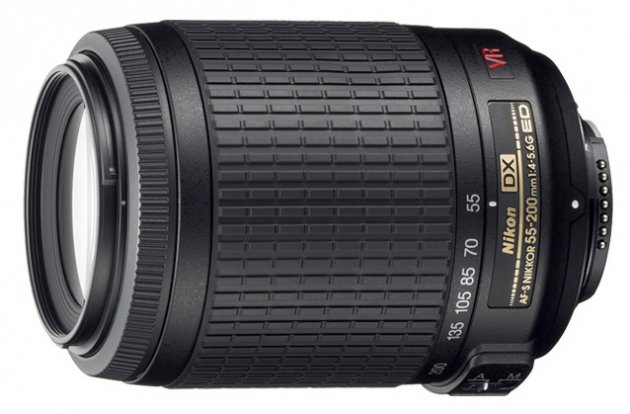 Weight: 11.8 oz.
Weight: 11.8 oz.
35mm equivalent: 82-300mm
Maximum aperture: f/4
What we like: Lightweight and cheap.
What we don't: Plastic mount.
If you picked up the 18-55mm kit lens—or even if you didn’t—both the 55-200mm VR and 55-300mm VR below make nice additions to your kit. This 55-200mm lens offers similar optical quality but has a plastic mount, is lighter at 11.8 ounces, and cheaper. It’s much cheaper, in fact, because Nikon has discontinued this model in favor of a new 55-200mm VR II version. You can’t go wrong with either version, but we would lean toward buying the older model as long as it stays in this very low price range and supplies last (the newer model currently is $347, or more than double).
See the Nikon 55-200mm VR
Nikon 55-300mm f/4.5-5.6 VR ($397)
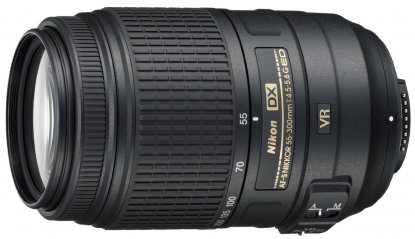 Weight: 18.7 oz.
Weight: 18.7 oz.
35mm equivalent: 82-450mm
Maximum aperture: f/4.5
What we like: 300mm of zoom.
What we don't: Pricey for a crop-frame telephoto lens.
The Nikon 55-300mm VR is the top telephoto zoom for DX-format cameras. It’s sharp, focuses quickly in most circumstances, and has vibration reduction (camera shake can be an issue with long zoom lenses). We like the extra 100mm of range, which can make the difference for wildlife and other close-ups. The downside of this lens is the maximum aperture of f/4.5-5.6, which can be a hindrance when natural light is low. But for photography in normal light, this lens is great choice with a very impressive zoom range.
See the Nikon 55-300mm VR
Lens Comparison Table
| Lens | Price | Type | 35mm | Aperture | Weight | VR | Filter |
|---|---|---|---|---|---|---|---|
| Nikon 18-55mm f/3.5-5.6 VR II | $847 | Kit | 27-82.5mm | f/3.5-5.6 | 6.9 oz. | Yes | 52mm |
| Nikon 18-140mm f/3.5-5.6 VR | $1,047 | Kit | 27-210mm | f/3.5-5.6 | 17.3 oz. | Yes | 67mm |
| Nikon 18-300mm f/3.5-6.3 VR | $697 | All-in-one | 27-450mm | f/3.5-6.3 | 19.4 oz. | Yes | 72mm |
| Sigma 18-250mm f/3.5-6.3 OS | $349 | All-in-one | 27-375mm | f/3.5-6.3 | 16.4 oz. | Yes (OS) | 62mm |
| Nikon 18-200mm f/3.5-5.6 VR II | $647 | All-in-one | 27-300mm | f/3.5-5.6 | 19.8 oz. | Yes | 72mm |
| Nikon 10-24mm f/3.5-4.5 | $797 | Wide angle | 15-36mm | f/3.5-4.5 | 16.2 oz. | No | 77mm |
| Tokina 11-16mm f/2.8 DX II | $429 | Wide angle | 16.5-24mm | f/2.8 | 19.8 oz. | No | 77mm |
| Sigma 17-70mm f/2.8-4 | $499 | Walk around | 25.5-105mm | f/2.8-4 | 16.4 oz. | Yes (OS) | 72mm |
| Nikon 16-85mm f/3.5-5.6 VR | $679 | Walk around | 24-127.5mm | f/3.5-5.6 | 17.1 oz. | Yes | 67mm |
| Nikon 35mm f/1.8 | $177 | Walk around | 52.5mm | f/1.8 | 7.1 oz. | No | 52mm |
| Nikon 50mm f/1.8 | $197 | Portrait | 75mm | f/1.8 | 6.6 oz. | No | 58mm |
| Nikon 55-200mm f/4-5.6 VR | $143 | Telephoto | 82-300mm | f/4-5.6 | 11.8 oz. | Yes | 52mm |
| Nikon 55-300mm f/4.5-5.6 VR | $397 | Telephoto | 82-450mm | f/4.5-56 | 18.7 oz. | Yes | 58mm |
Lens Buying Advice
- Our Dream Camera Bag
- Zooms lenses vs. prime lenses
- Crop factor
- Third-party lenses
- FX lens compatibility
- Back to our lens picks
Our Dream Camera Bag for the D5500
The D5500 sits in the middle of Nikon’s DX lineup above the entry-level D3300 and below the enthusiast D7200 (in 2016 the pricey D500 will take the throne). It’s been called an “advanced beginner” DSLR, and accordingly, we think the ideal match for it is the 18-140mm f/3.5-5.6 kit lens. It does have limitations in low light and levels of distortion that you might expect from a zoom of this type, but it’s far better than the 18-55mm VR II and considerably cheaper than the 16-85mm and 16-80mm (not to mention the longer zoom range). You may want to add a prime or specialty zoom as your photography skills advance, but the 18-140mm is a terrific place to start.
There has been a lot of hoopla surrounding the new Nikon 16-80mm f/2.8-4, which hits the popular 24-120mm focal length range and is better in low light than the majority of DX zooms. For the D5550, at over $1,000 the 16-80mm is way too expensive for our tastes, not to mention it’s not head and shoulders better than the 18-140mm that is one-third the price. Advanced beginners seeking better low light photography should consider the Sigma 17-50mm f/2.8-4, a fun lens and another great value.
Those who frequently shoot telephoto photography should add the 55-300mm f/3.5-5.6. We love the extra long zoom range at a 450mm equivalent, taking you well beyond the 18-140mm kit lens (the 55-200mm is cheaper but only goes 60mm further).
Zoom Lenses vs. Prime Lenses
Both zoom and prime lenses have benefits and shortcomings. Zoom lenses cover a range of focal lengths and therefore are more versatile—you can literally get an all-in-one lens like the Nikon 18-300mm and have every focal length covered from wide angle to telephoto. Prime lenses have a fixed focal length but generally are faster, have less distortion, are lighter and cheaper. The D5500 does have an automatic distortion correction mode, which is quite helpful when using zooms.

For an advanced beginner DSLR like the Nikon D5500, zoom lenses are a great choice. They are versatile, easy to use, come with Vibration Reduction technology, and will help you think less and focus more on taking photos. Prime lenses like the 35mm f/1.8 and 50mm f/1.8 are better in low light and make nice additions if you plan on shooting frequently at those focal lengths, but Nikon’s zooms continue to improve and have become quite competitive. We recommend starting with a zoom lens and adding primes at your desired focal lengths should you want them down the road.
Crop Factor
Nikon DX cameras like the D5500 have a 1.5x crop factor, meaning that a 50mm lens will behave like a 75mm lens would on a 35mm camera. The history behind crop factor is long, but what you need to know is that the focal lengths of a lens are described using 35mm film as the reference point. Because the image sensor on Nikon DX cameras is 1.5 times smaller than a 35mm camera, you multiply the listed focal length of the lens by 1.5 to determine its equivalent.
If you’ve used a full-frame camera, crop factor can be very helpful in choosing your lenses. For example, the Nikon 10-24mm wide-angle lens is equivalent to 15-36mm on the D5500, which actually is much more useful than the listed range. Make sure to keep this conversion in mind when making your lens decisions.

Third-Party Lenses
We always consider third-party lenses when creating our buying guides. The truth is that Nikon makes some of the finest lenses on the planet in terms of autofocus, sharpness, and overall image quality. But manufactures like Sigma, Tokina and Tamron make lenses that are compatible with DX-format cameras like the D5500 (make sure to get the Nikon DX mount). All things considered, these lenses usually are cheaper than their Nikon counterparts and at least slightly inferior optically (not in all cases, but usually).
We find third-party lenses to be most beneficial when they cover a specialty focal length that you may not be able to afford otherwise. They’re also handy when they just flat out outperform comparable Nikon lenses for the price. For example, the Sigma 17-70mm f/2.8-4 is a really solid zoom lens for D5500 users. At $500, it costs significantly less than a lens like the Nikon 16-80mm f/2.8-4 yet provides many of the benefits. Of all third-party manufacturers, Sigma is our favorite and gives Nikon the best run for their money (Sigma also makes their lenses in Japan).
Two of the most common issues we see with third-party lenses are slow autofocus and softness. The autofocus makes sense: one lens often is made with multiple mounts for Nikon, Canon, Sony, and Pentax DSLR cameras, all of which have varying autofocus systems. The third-party manufacturers do a pretty nice job of making these lenses compatible across the board, but it’s not always perfect (in their defense, Nikon autofocus isn’t always perfect either). In terms of sharpness, these companies often compete by undercutting Nikon’s higher pricing, and one way to achieve this is with cheaper components and glass. Again, it’s not that third-party lenses are far inferior, but you may see more softness than you would from a Nikon lens.
FX Lens Compatibility
Most Nikon FX (full frame) lenses are compatible with DX cameras like the D5500, but we don’t recommend them. First, FX lenses are much more expensive and heavier than DX lenses. Second, you won’t be utilizing the full potential of the lens—the area that extends beyond the crop sensor will be cut out of the photo. If you already own FX lenses, you can absolutely use them on the D5500, but we wouldn’t recommend buying FX lenses specifically for use on this camera.

